Archive for October, 2010
Interview: Shaun Gladwell on Afghanistan
Oct 25th
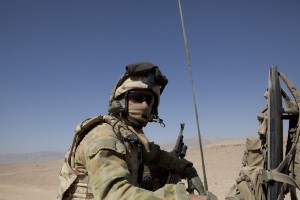 I interviewed the Australian artist Shaun Gladwell on November 13, 2009, after his return from Afghanistan where he had spent the month of October as an official Australian War Artist. My subsequent article appeared in The Art Newspaper.
I interviewed the Australian artist Shaun Gladwell on November 13, 2009, after his return from Afghanistan where he had spent the month of October as an official Australian War Artist. My subsequent article appeared in The Art Newspaper.
I have decided to publish the full text of my Gladwell interview on this website, in response to a reader’s email which asked how Stephen Dupont’s experiences in Afghanistan would have compared to Gladwell’s, given that Dupont is a documentary photographer and Gladwell worked in Afghanistan as an official Australian War Artist.
I thought the best way to satisfy the reader’s query was to present the full transcript of my interview with Gladwell. In this way, his comments can be compared with Stephen Dupont’s, whose interview also appears on this website.
A few years ago, Shaun let the Australian War Memorial know that he was interested in being a war artist. “I had an interest in that way of working,” he said. After a few years the AWM rang him to say they had considered him and it was possible. They contacted him around the time of the Venice Biennale ’09, in which Shaun exhibited. A curator from the AWM came to his studio and “a relationship formed slowly over a period of time”.
Here is the Gladwell interview, edited very lightly:
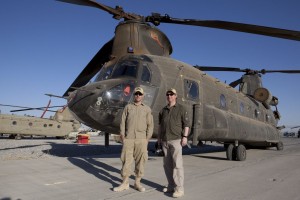 ArtWriter: Why were you interested in gaining a commission as an Australian War Artist?
ArtWriter: Why were you interested in gaining a commission as an Australian War Artist?
Shaun Gladwell: It was an interest I’ve had through my family. My father had a history with the military and he had served in Vietnam and my grandfather had served in World War II and my great grandfather was in World War I. Yet I didn’t really choose that path at all. And yet I was always interested in their experience and tried to imagine what it would be like for them. It was very difficult. I could never really empathise. Also I had become aware of the British Imperial War Museum. They have a similar program. There were a few artists that were involved in the British commission, people like Steve McQueen who I knew and Langlands & Bell who I don’t know but I know of their work, so there was a few things that connected the dots and led me to think about this kind of way of working.
Tell me about your father’s career in army?
He’s retired [from the army]. He stayed in the army reserves for a little while. It certainly had an impact on his life. Over the years he’s been more forthcoming about his experiences and that has been interesting for me to think about and try and understand. It certainly was something that was close to home.
Was your father already in the army before Vietnam?
He was a professional soldier but he did enlist during the conscription period so it didn’t take him very long, he was deployed rather quickly. He was quite young as well. He signed himself up rather than being conscripted.
You were an army kid?
Yeah, I was just aware that that was a part of his history. He started his family once he had returned from Vietnam so it was all before I was born. It was a fresh experience for him. It was something I was thinking about and it was kind of like an entry point for me into thinking about this experience I have just had in Afghanistan.
Did he say anything to you about your trip to Afghanistan?
After all the anecdotes and stories that he had told me over the years I think I was a bit more prepared to deal with military culture. It was a very different conflict that I saw compared to what he must have been involved in. In a way of course there’s the same organisation but a different era and different field of conflict. Also there was this real difference that was something I wasn’t prepared for. Just because it’s such a different environment in Afghanistan and different kind of cultural logic. There was similarities and differences for sure.
What shocked you most when you got to Afghanistan?
It was probably the landscape, that was the thing that really shocked me. It was just so kind of vast and enormous and grand. At times it was inhospitable and it was also incredibly lush and green and dense in a matter of metres, the way the water was used and irrigation has been developed. [There were immense mountain-scapes then really severe desert.] I think I was impressed by the enormity of that space.
[Shaun has made artworks about vast Australian landscapes, so I asked him why he was still shocked by the vastness of Afghanistan.]
Yeah, I think the mountains. I’m really taken by landscapes. They become a real point of interest for me. But also I guess the vast scale of the military presence over there, that was also pretty overwhelming, the size of certain military bases and the infrastructure. I was overwhelmed by the size of the environment I was in and also the kind of system that I was operating in as well.
Are the army personnel impressive?
That’s always been of interest. I guess it’s a very different conflict to a war where there was conscription. Everyone deployed at the moment, especially in the Australian contingent, they are professional soldiers who are highly trained and very engaged with cultural protocol and engaged in their work and that was pretty amazing to just know how much local knowledge they had. The surrounding culture as well as the landscape. So that was a real surprise. They had a real connection to the local culture, which is really impressive. A lot of the guys had connected with the language and knew a lot of cultural practices and had quite an understanding of how that culture operates on a day to day level.
There’s not so much a front line in Afghanistan?
Yeah, and the guys that I spent time with were very good at connecting with locals and making sure that their presence there wasn’t like a major disruption or that the initial kind of reception isn’t a hostile one, it’s actually a really friendly one. I guess that was kind of heartening to see there is this side to the conflict, and the children of any village that we would roll through would always be the first to run out and wave and the soldiers were really good at being receptive to that. That kind of stuff was heartening. There was also some stuff that was really quite harrowing in terms of the conflict. That stuff kind of gave it a context and also gave me a bit more of an overall picture. It’s just not a conflict that involves combatants going head to head; there’s kind of a complex negotiation taking place over there.
What was the harrowing experience you mentioned?
I think probably the most confronting thing that I saw was a field hospital in Kandahar which was quite tough because I saw a lot of casualties. It’s probably not any different to an emergency or trauma ward in a hospital anywhere in the world, but just the fact that you see casualties through warfare and that’s the difference, and different kinds of casualties. I didn’t actually record that experience; it was just something that I took on board as something that will kind of inform the work perhaps, but I didn’t feel it was appropriate to record that, but that was really quite tough.
Were the casualties military or civilian?
The hospital was dealing with everyone. I was pretty impressed with the hospital staff because they were doing an incredible job as well. They were working pretty hard and around the clock. It was in Kandahar, a hospital that was dealing with the Coalition but at that stage it was a Canadian role 3 hospital. Jointly run by the Canadians and a few other forces. A lot of Australian doctors were working in that hospital.
Were you filming most situations?
Yeah, if I felt like it was of interest to me in terms of my work I would either photograph or at some points I would even video things or sketch things. At other times it just didn’t seem appropriate or wasn’t possible because they were moving too fast through different situations.
Did you get to meet local people?
Yeah, I did. There was one or two markets that were set up that some of the troops were able to access that was supporting a lot of local business which was great. In patrol situations we were moving through villages so there was interaction there. So there was an opportunity to connect to the local culture, which was great.
Are the local people living in totally traumatic way?
It’s hard for me to assess that because I didn’t know what had gone before. But from what I can tell through the successive occupations before this phase of the conflict I can imagine in certain areas of Afghanistan there has been this ongoing trauma, and that’s quite tough. But I find that hard to comprehend because it’s so far away from my own experience but it certainly did inform the way I was looking at those regions. People in certain areas of Afghanistan are impoverished and living in subsistence situations. That was quite confronting. I guess the frightening thing was there was quite a lot of reconstruction and mentoring work, a lot of aid effort. I was in Tarin Kout in the base we share with the Dutch in Oruzgan province. There was also at that point quite a lot of people from AusAid. Looking at a children’s school they had constructed in the township of Tarin Kout. It was great to hear a report of this school and how it had gone from strength to strength. For all of the kind of tragedy that I was experiencing, there were these stories of hope that were offsetting that. It was a situation where I was pretty lucky I didn’t get into a full-scale combat situation. It was just lucky I didn’t get caught in the middle of that. But it was kind of a bit of tension going out on patrols, that’s for sure. We did get to move through a lot of landscape. We were right out there in the middle of this wild and various landscape which was tense and wonderful in equal measure. I also went to Kandahar. Travelled through and stayed in bases. I did have to move pretty quickly through some areas because I wanted to see as much as possible. It wasn’t like casual travel; it was more being part of patrols or operations in those areas.
How did you work out your itinerary?
I asked them what I’d like to do and they kind of built an itinerary around that. They’d really help me try and get to as many things as I’d asked to see. I was also interested in base life. It was good to get a variety of experiences.
What is the purpose of the patrols you went on?
Every one [of the patrols] has a different aim. There’s different kinds of sections of the military involved in these patrols. Some are for strategic, combat role, others for mentoring, reconstruction, protecting aid workers, others are for resupplying other bases. There are quite a few things taking place over there at any one time.
How did you find the Australian military personnel?
I thought I would be judged against and put into a kind of category which is the kind of journalist category, but actually the military were really quite good with journalists and with me because I was kind of this artist and I thought it would be difficult but in actual fact they were great. [Shaun lived with the troops and ate the same food as they did.] It was a better way for me to understand what they were going through. In bases you’re living and working and eating with the guys and girls, so it was quite a good experience in terms of trying to connect in that way.
Did you have freedom or were you censored?
No, I didn’t feel censored. I think I was advised on certain things if what I tried to do was too dangerous, not that that really happened. I didn’t really have that as part of my project anyway. I wasn’t interested in photographing sensitive material, in terms of the technology or weapons. My interest was really the experience of the soldier as a thinking and feeling subject and someone who’s having to try and assist quite a lot within their kind of environment and their experience of that landscape and how it affects them.
Did you got there with a plan in mind?
I didn’t try and have too many expectations because I figured all my preconceptions of the place would be quickly shattered and they kind of were. So I did try and just go in with a kind of openness. There’s always things I’m interested in in my work in general. Like I’m interested in how bodies move through space and the capacity of bodies to perform in certain situations. Particularly how it relates to landscape. These are issues I’m always interested in. That informed the way I was dealing with that experience in Afghanistan. But I didn’t try and direct anything.
Will it take a long time to absorb your experiences in Afghanistan? Will your resulting work unfold over the years?
I think it is kind of on-going engagement. But certain things I want to work on sooner rather than later while this experience is fresh. In the next six months I will be pretty focused on what’s just taken place. [Shaun’s video and photographic art installation, titled Double Field, was launched at the AWM in July, 2010.]
Do you think the conflict in Afghanistan is winnable?
It’s really difficult for me to comment on that because I figured I was never really involved in a political discourse, I was more interested in the politics of representation. Difficult to assess because on a communal level I would see soldiers given a particular task and they were successful in carrying it out. We are only a small part in a bigger puzzle over there. The Australian forces working with the Dutch are in a pretty complicated and dangerous area but I know that we are moving forward where I know that a lot of other regions are moving backwards in a lot of ways. So it was very tough for me to generalise and conflate what I was seeing, and then thinking that that’s a fair assessment elsewhere. I know it’s not going to be resolved quickly and easily, that’s for sure.
Did you meet any of the Australian troops who were subsequently killed?
I had an opportunity to meet colleagues of two of those troops who had fallen in service and that was tough, but there’s quite a lot of respect for them and certainly their colleagues were amazing to just press on and it was interesting to see how they were dealing with that situation. It is a war zone, and those things are kind of at the back of a lot of people’s minds; at the forefront sometimes, which is quite tough psychologically. But it was amazing to see how strong a lot of those guys and girls are over there to press on.
Were they like the troops in George Gittoes’ films?
It’s good to remember the UN organising body have quite a few different nationalities. For every different nationality there’s a different operating logic and the Australians are known for having a very high level of morale and they’re quite famous for also being quite friendly and easy going. It sounds like a cultural cliche that I was quite sceptical of, but it’s actually quite true when I see how Australian forces are regarded by other nations and that was quite interesting. [Gittoes focused on the Americans] but the Australians have a different kind of presence over there. Certainly it’s not mutually exclusive. There is incredible mateship throughout that whole coalition and there is humour and there’s definitely this human side to it. We have a particular take on how all that takes place within a community of people and it’s quite exciting to see it all alive in a very different world to the homeland Australia.
That’s why the AWM sends artists over there?
Sure, that’s part of the challenge. The idea of trying to process all these very different experiences. It’s quite brutal and it does seem complicated and overwhelming, but at the same time it is human beings who in the Australian case we know well and how they operate and they’re all kindred spirits trying to get a job done. It’s very inspirational, that’s for sure, so I’ll definitely spend the next six months trying to digest it, in a sense. It was certainly an experience I’ll never forget.
Would you go back?
I kind of figure the time I had over there was kind of unique. The subject changes constantly and even if I had the opportunity to go over there again I can imagine it would be a very different situation so I’m really cherishing that and starting to analyse what’s taken place at this particular time because it really is a slice of time that I’m going to work with now.
Were you able to keep some souvenirs? Your helmet, perhaps?
Not the helmet. Helmet and body armour are quite heavy and also restricted back in Australia. So I had to hand that back in on the way home. That’s OK, I wouldn’t have too much need for body armour back here anyway. I had to return it for the next person who needs it over there.
© Elizabeth Fortescue 2009 (Full transcript added to www.artwriter.com.au on October 25, 2010)
Euraba paper artists win Parliament of NSW Aboriginal Art Prize 2010
Oct 22nd
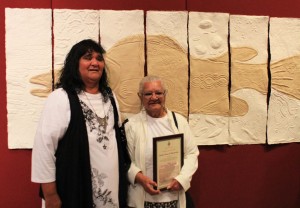 The Euraba Artists and Papermakers of the northern NSW town of Boggabilla have taken out the 2010 Parliament of NSW Aboriginal Art Prize, awarded to them at Parliament House this week.
The Euraba Artists and Papermakers of the northern NSW town of Boggabilla have taken out the 2010 Parliament of NSW Aboriginal Art Prize, awarded to them at Parliament House this week.
This picture shows representatives of the Euraba collective with their winning artwork, titled Gaduu – Murray Cod. The work is in mixed media using plant fibres and rag paper.
You can catch the exhibition of prize finalists at Parliament House until Thursday October 28, 2010, after which it will be touring NSW regional galleries. The prize is organised in collaboration with Campbelltown Arts Centre.
Elizabeth Fortescue, October 22, 2010
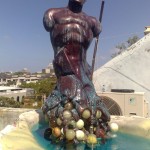
Sneak preview: Studio pictures of Bjorn Godwin’s work for Sculpture by the Sea, Bondi, opening October 28
Oct 18th
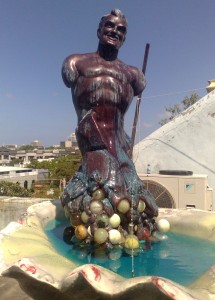 Here’s a sneak preview of Bjorn Godwin’s sculpture to be exhibited in Sculpture by the Sea from October 28, in Sydney. I photographed it last week when I interviewed Godwin for my story in today’s Daily Telegraph.
Here’s a sneak preview of Bjorn Godwin’s sculpture to be exhibited in Sculpture by the Sea from October 28, in Sydney. I photographed it last week when I interviewed Godwin for my story in today’s Daily Telegraph.
Yep, it’s an adaptation of Chesty Bond, the logo that Bonds used for many years to advertise its singlets. The model for Chesty was Max Whitehead, who died in March this year. Max had been a wrestling champ and surf lifesaver, not to mention the first caption of the Manly Sea Eagles rugby league team. Believe it or not, Max was also a chicken-sexer in the sporting off-seasons.
Godwin’s sculpture is titled Golden Boy (for the convenience of passers-by). The title makes reference to the undergraduate antics of the editorial team of Oz magazine back in the 1960s when they posed for a famous photograph which appeared in Oz and landed them in court on obscenity charges. In the picture, the boys appeared to be relieving their bladders into the Tom Bass P&O Wall Fountain. The fountain is let into the side of an office block in Sydney’s CBD.
Golden Boy, according to Godwin, is also commenting on the Australian predilection for nationalistic monuments. Like many of these monuments, Golden Boy will be surrounded by a white-painted chain fence.
There is a clear art-historical reference in Golden Boy, where Chesty Bond emerges from his oyster shell in the manner of Venus emerging from her shell in Botticelli’s famous work.
I was taken with Godwin’s studio on the rooftop of a tiny building in Chippendale, near Broadway. It was reminiscent of Le Corbusier’s Notre Dame du Haut, which I have only ever seen in my old school art book. There was the same curved roofline and tiny square windows. You can see them in my pictures. Elizabeth Fortescue, October 18, 2010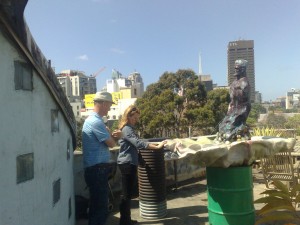
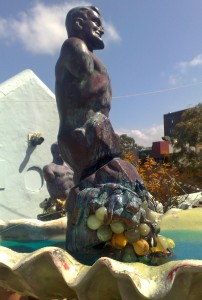
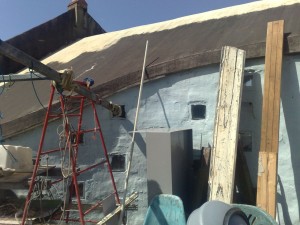
Stephen Dupont talks to ArtWriter about his forthcoming exhibition at the Australian Centre for Photography
Oct 11th
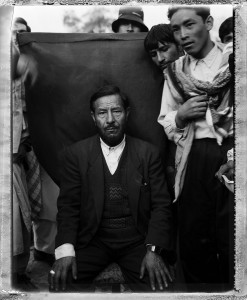
Australian photographer Stephen Dupont is putting the finishing touches to his next exhibition at the Australian Centre for Photography, to go on show between Friday 15 October – Saturday 20 November 2010. The show is titled Afghanistan: the Perils of Freedom 1993-2009.
Last week, I interviewed Stephen in his Mascot studio so that I could write an article about him for the Daily Telegraph. The story appeared today (October 11, 2010).
However, given the importance and interest of Stephen and his work, I thought that many people would enjoy reading the full text of our interview as it was recorded and transcribed by me. Here it is. I have edited it lightly:
ArtWriter: Can you talk us through the ACP exhibition and what it will cover?
Stephen Dupont: [It will be] a very much edited body of work from 15 years of coverage. It ranges from 1993 through to 2009. Essentially it’s a retrospective of work from that period. I’ve been incredibly selective. In order to do the story justice I’ve decided to do a lot of installation kind of work. So for instance these are small mock-ups but the exhibition will have entire book dummies right across the walls, almost like wallpaper. These are the original Moleskin pages. They’re going to be huge. So people will see the whole dummy that I’ve made. That’s another booked called Stoned in Kabul. So people can read it, see the work, and it also involves my handmade books which is a big part of what I do. The whole exhibition is quite ambitious; it’s not like anything I’ve ever done before. It’s going to be incredibly busy. It’s not about cramming everything in. It’s really about giving the work room to breathe, and also tell the story, because it goes beyond the photography, it goes to the history and politics and everything else about what’s been going on about Afghanistan over the last 15 years. So it’s also these elements are shown, and also in an artistic sense they’ll look really interesting as well. My diaries will be in there as well. It opens up a whole other message, I suppose.
So you’ve got that element, then you’ve got a suicide bombing. This is probably easier to explain by running through the gallery. So when you enter there’s going to be a huge mural of [Ahmed Shah] Massoud, then the exhibition starts with the civil war, 1993-1998, these are all single photographs, then it moves into Massoud who was the former leader of the Northern Alliance. He was assassinated two days before September 11 and he was Afghanistan’s real hope of peace. And he’s now the national hero. I spent a lot of time with Massoud. He’s an important part of my work. This is all in chronological order. Then you go into the war on terror, which is 2001 to 2009. So that’s basically when the Americans and NATO forces arrived. Then you get to the huge mural called Taliban Burning. You might remember there was a photograph and also video footage that I’d taken of American soldiers burning the bodies of dead Taliban which started controversy around the world. It’s the size of a wall, basically. It’s a huge print. And it’s meant to shock people. It’s an intimidation of what took place. And there’ll be an excerpt from my diary about what happened. Each section has an excerpt of my diaries, so it’s like a message for people to read about something that happened at that particular time that I reflect on.
This room here is called Axe Me Biggie. It’s a series of portraits I made in 2006 of anonymous, mostly men made on the streets of Kabul. It was shot in an afternoon and these are life-size mural portraits taken on Polaroid. They were taken with a traditional Afghan photographer’s backdrop which is all crumbly and decrepit. I basically used that outdoor studio kind of feel to make these portraits.
Then you go into this installation room. So you’ve got Stoned in Kabul, this book dummy, basically taking up that whole wall. It’s about heroin addiction. This project is about two brothers addicted to heroin. And it’s a window into the whole narcotics situation in Afghanistan, but mainly from the point of view of addiction and how local people have suffered from the blow-back of Afghanistan being the world’s biggest provider of heroin and how it’s affecting the local population.
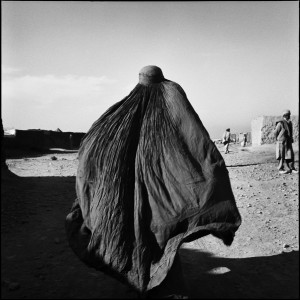 Then you’ve got Why am I a Marine?, my most recent work. This was a series of portraits I’d done on one American Marine Platoon in Helmand province. I photographed them and I put a question, why am I a Marine? to everyone in my journal, and they all wrote a personal testimony about why they became a Marine.
Then you’ve got Why am I a Marine?, my most recent work. This was a series of portraits I’d done on one American Marine Platoon in Helmand province. I photographed them and I put a question, why am I a Marine? to everyone in my journal, and they all wrote a personal testimony about why they became a Marine.
Then the suicide bombing is here. I was in this bombing incident in 2008 where I escaped this suicide bombing and photographed the aftermath. So there’s 60 pictures almost like a contact sheet, before and after the bombing. That takes up that whole wall. It’s very graphic, as you can imagine it is.
The last section is Yesterday, Today and Tomorrow, which is a reflection on photographs that are personal and poetic and so forth that I think really represent Afghanistan yesterday, today and tomorrow and that’s going to be a grid of bout 15 photographs. Then you’ve got contact sheets on each of these walls that are going to be plastered down the side. You will not be able to get away from imagery. It’s going to be a flood of pictures. And that’s the intention. It’s an incredibly busy show and I’m hoping that people will take time to really take that journey and take in my journey and the journey of the war in Afghanistan.
It will be interesting to see if I pull it off.
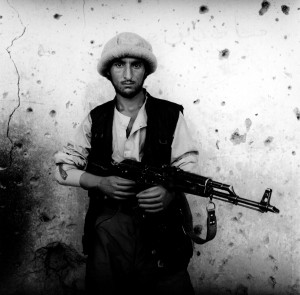 How did you get involved with Afghanistan in the first instance?
How did you get involved with Afghanistan in the first instance?
I had been reading books and researching, and the romanticism of Afghanistan and the “great game” and the spying through the British and the Russians from books like Peter Hopkirk had written about it, and Rudyard Kipling, Kim, so there was this romantic notion of Afghanistan, this wild frontier and then the amazing imagery of Mujahideen fighting the Russians so it was incredibly appealing to me as a photographer back in 1992-93 when I’d just moved to London. Then I read a report about … the civil war in Tajikistan had broken out and 100,000 refugees had fled, the Russians were starting to pull out of Central Asia but they were still very much in control of Tajikistan and when the civil war broke out the Russians were shotting the refugees as they tried to swim across the river into Afghanistan. So this massacre took place. And the refugees who made it into Afghanistan ended up in these squalid camps in minus 20 degrees Celsius conditions in the middle of winter. And I read this story and I just thought this is f…ing unbelievable, the fact that you’ve got to flee a civil war and you go to Afghanistan? It’s like Afghanistan has got a civil war erupting itself and it’s worse than the place you’ve just come from. How f…ed is that? As a refugee, that your only salvation is Afghanistan? I just thought this is the most absurd situation, and horrific situation. So I went and covered that story for my agency and papers and people in London, and while I was there covering the refugee story I met some doctors from Medecins Sans Frontieres in Mazar in the north, and they were saying to me you should go to Kabul because the whole city is under rocket attack and there are tens of thousands of people being killed and there’s only one journalist there, and it was just like no one was covering it back then. So I took this road journey with a doctor. I disguised myself as a doctor to get through all the check points, so I hid my cameras in the back of the car. I got looked after by MSF [Medecins Sans Frontieres] in Kabul. We made it into Kabul under rocket attack. The whole city was just being bombarded every day just continuously from various different factions fighting over the city. So it was this incredibly intense and insane situation, running around the streets of Kabul trying to photograph it and trying not to get blown up. I decided to focus on MSF and what they were doing. It was only like three or four international doctors that were there. Not many other aid organisations were there, it was just too dangerous. So this hospital that they were running, which was the main hospital in Kabul, was flooded with the wounded and dead from the rocket attacks. So I did this essay around what MSF were doing and the situation around how civilians were trying to survive in this Grozny-like city which was just completely destroyed. That was my introduction. I went back to London and got itchy feet and thought I’d better go back again. You really get caught up in the story. I really felt for the people. I felt it was important to cover this story because no one else was really doing it and it was an incredibly important story for the world to know about. If anything, I thought I’d get my pictures published, but it would be this body of work that I would hope that one day that it would be a template of history of the people of Afghanistan. I had no idea that 2001 would come along and the whole world would focus on Afghanistan. I’d already been going there for eight years. When that happened it was almost another chapter.
When that happened in 2001 I couldn’t stop, so the journey never ended in a way, although now I’m starting to put everything together because you need to put closure on things and this for me is the closure on putting this show together and publishing a book.
I’ve kept diaries right through. I do different things for different bodies of work. I made these books. [Stephen showed me a couple of his artist’s books, all printed by him and put together by a bookbinder. They have a kind of Bauhaus aesthetic, and are gorgeous to look at and handle.]
The exhibition is really about showing this kind of thing in a gallery context, as well as traditional prints. They’re also looking at getting a table for objects so I can lay out these books.
It’s a lifetime’s work, basically, and I’ve only got a certain space to fit it in.
Where were you on 9/11?
I was about to go and meet Massoud. It was extraordinary because I’d already got my ticket and visa, I had planned to go and on another trip with Massoud and September 9 he’s blown up. I was in shock; it was shocking. And of course my gut feeling was that I should still go because this is going to have huge repercussions on the civil war andwhat was happening with the Taliban and so forth. I was still on my way to go there, and two days later September 11. I was sitting in my lounge room and watching it live, in Sydney. I knew that this was somehow connected and that there would be some huge repercussions from that as well. Whatever happened I knew I had to be in Afghanistan and I ended up in the first stream of journalists trying to get into northern Afghanistan and I ended up going in for about six weeks on that trip as the Americans started bombing and the whole thing kicked off. I went in with the Northern Alliance, as most people were doing.
I can’t even imagine how you live? Where you sleep?
Anywhere you can. Basically you’re in bandit country and you just hope you don’t get rolled.
You live on your wits?
You live on your wits, but often you’re with other people. It’s not often I was alone. I would usually have a couple of other journalists with me. Safety in numbers. It tends to be OK. I’ve never, touch wood, had any huge issues. Not from the travelling aspect of it. I even walked out, just myself and a couple of Afghan guards, out into Pakistan. That was like a week on foot and horseback because it was the quickest way out. Not the safest but the quickest. Otherwise I would have been stuck there with 1000 other journalists trying to get out. It was a really bad situation where the whole world’s media had flooded into Afghanistan and then everyone wanted to get out again. They were all sleeping at a place in the Panjshir where a helicopter would come and retrieve a few people at a time. I remember going there and looking at all these dejected journalists, really depressed, and some had been waiting for, like, four or five days, and there was no food or running water. I had already arranged to meet an Afghan commander in the north and pay some guards to take my out into Pakistan. It was an amazing journey.
This exhibition is about people and Afghanistan, but it definitely has a lot to do with my journey and how I reflect and what I’ve seen. It’s very personal.
How does this change you as a person, being a witness to human misery?
My parents were social workers. I grew up around a lot of displacement in a way. Maybe that had something to do with my attraction to thrid world misery ro something. I had a fairly normal upbringing I suppose. Photography came first then the inspiration for doing social documentary and news reporting was second. I very much started as a news photographer, freelance, running around the world chasing stories. I’ve developed much more into a more personal vision and opening up my diaries and trying to say something more personal.
Is this the first time you’ve opened up your diaries?
Yes, in a gallery sense.
What other conflicts have you covered as a photographer?
I covered the Angolan civil war in ’93, then Zaire and Somalia. Sri Lanka civil war, the Middle East, Rwanda and the genocide. A lot in Africa. Africa and Central Asia were the two main areas I focused on.
You spoke before of closure. Do you see this exhibition as the end of your work in Afghanistan?
No. I’m planning to go back next year and shoot a documentary film. It would be just another chapter of my life. I’m hoping to do a film about the Marines.
Do you have friends in Afghanistan?
Definitely. I have Afghan friends and contacts that I’ve seen on different trips, and expats. People come and go. Sadly a lot of people die. A lot of people I know have died or been killed because of the war. It’s a very transient place, and constantly changing. Constant struggle of dealing with the horrors of war. These people have had nothing but war, and they still have war. People are still suffering and still dying. Civilians. For me this is a dedication to the people of Afghanistan. This is my thanks for the access and the friends and the safety and camaraderie.
Are the Afghans good people?
Amazing people. Incredibly honest and resilient. So diverse and culturally wonderful and intelligent. So much history. One of the big things that attracted me was to do with their history and culture.
Because of our government’s f…ed up attitude towards refugees and asylum seekers, I’m quite interested in somehow exposing something that exposes the struggle that asylum seekers have in this country, and a lot of those asylum seekers Afghan or Hazara people so when they get back to Afghanistan their future is nil. If they’re not killed, they’re persecuted. So for me there’s a powerful message in trying to highlight that situation.
That was the end of the recording.
Afterwards, Stephen told me he shoots almost exclusively on film, not on digital.
“I guess I’m a bit old school in that way,” he said. “If I have to shoot colour, I sway towards digital. But I normally shoot black and white.”
He uses Leicas, Polaroids (yes, Polaroids) and Rolleis.
Elizabeth Fortescue, October 11, 2010
Opening of the new Indigenous Galleries, National Gallery of Australia
Oct 2nd
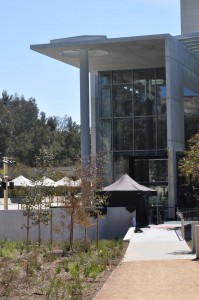 On Thursday I attended the press preview of Stage One of the redevelopment of the National Gallery of Australia, in Canberra. These are the photographs I took on the day.
On Thursday I attended the press preview of Stage One of the redevelopment of the National Gallery of Australia, in Canberra. These are the photographs I took on the day.
The first picture (left) depicts the new front entrance to the gallery. You pass through two sets of sliding glass doors and immediately find yourself inside a vast foyer, filled with light (below).
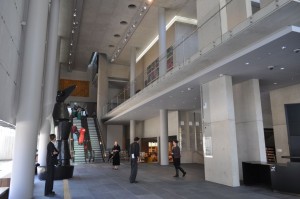
The gallery’s famous Aboriginal Memorial is immediately to your left in a kind of circular well in which it receives abundant natural light and is shown to great advantage. Margaret Olley told me on the day that she had never seen the memorial (below left) “look so spiritual”. The new shop (below right) and cloak room are also in the foyer.
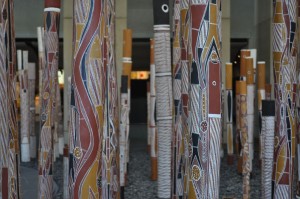
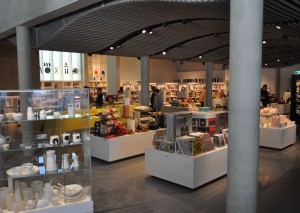
When you are standing in the new foyer, you will see a set of escalators right in front of you. Take the escalator up, and you are in the new indigenous galleries.
I think you will be able to see from the following photographs that the new galleries are a wonderful achievement. Most of them are lit with natural light, while those which contain drawings and other fragile materials have a special feature – they are lit artificially, but the lights are triggered only when someone enters the room. From a conservation and preservation point of view, this is an innovative and impressive idea.
National Gallery director Ron Radford gave a short speech in the foyer, welcoming particularly the 40 indigenous artists who had travelled from all over the country to be at the ceremony.
We went up to the new galleries, where artist Gali Yalkayirriwuy Gurruwirri performed a ceremonial dance (below left and right).
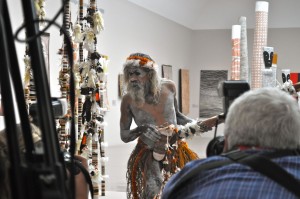
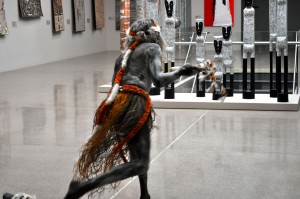
Among those watching the performance was the Maningrida bark master, John Mawurndjul (below).
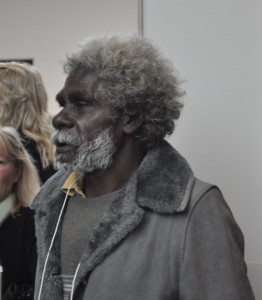
Mawurndjul and fellow Maningrida artist Owen Yalandja (below, with one of his works) were to return to their home the day after the opening, to attend an important men’s ceremony.
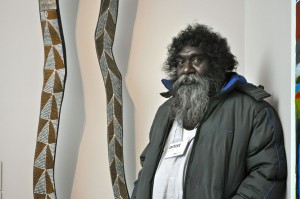
Here are some more pictures, showing the inside of the new indigenous galleries.
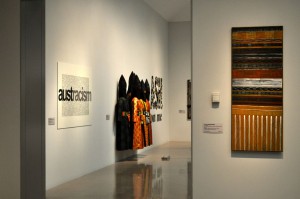
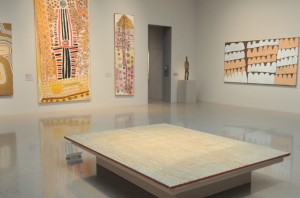
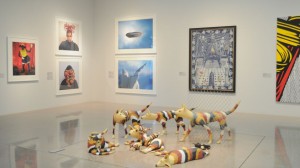
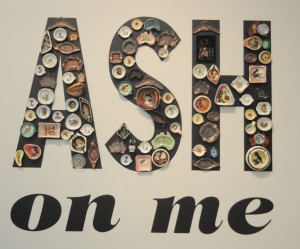
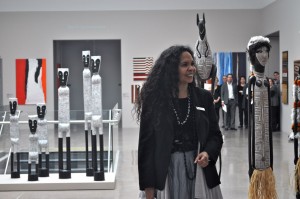 Francesca Cubillo (left), senior curator of Aboriginal and Torres Strait Islander art at the National Gallery, warmly thanked the artists for attending.
Francesca Cubillo (left), senior curator of Aboriginal and Torres Strait Islander art at the National Gallery, warmly thanked the artists for attending.
And finally, on the way out of the building, I met Thanakupi, the artist from Weipa, and spoke to her about her sculpture which was commissioned for the extensions to the building. Titled Eran, meaning “river”, the work depicts animals in the creation stories of the tribes along Weipa’s two rivers – the Evath eran and N’Gath eran. In English, these are the Mission River and the Hay River.
This is Thanakupi’s statement: “The sphere is circle. It is what I centred on in making pots. When looking at the world, it’s unity and the world. Taking that sphere and the designs, that is my art. Fire, earth, mother, unity. Designs on the ground, now on the bauxite, from clay to aluminium.”
Here is a photograph of Thanakupi’s work, Eran.
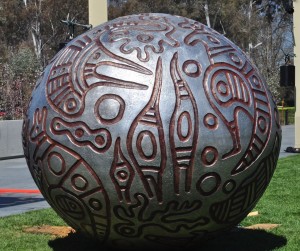
Elizabeth Fortescue, October 2, 2010
